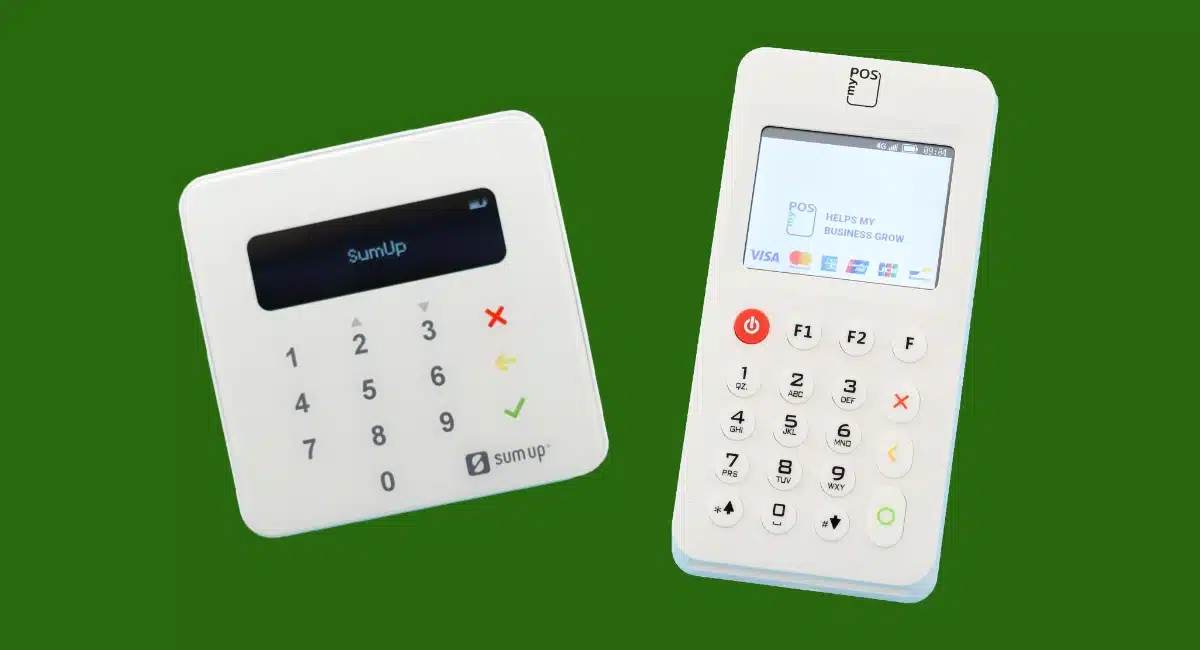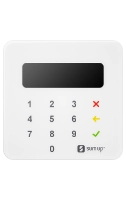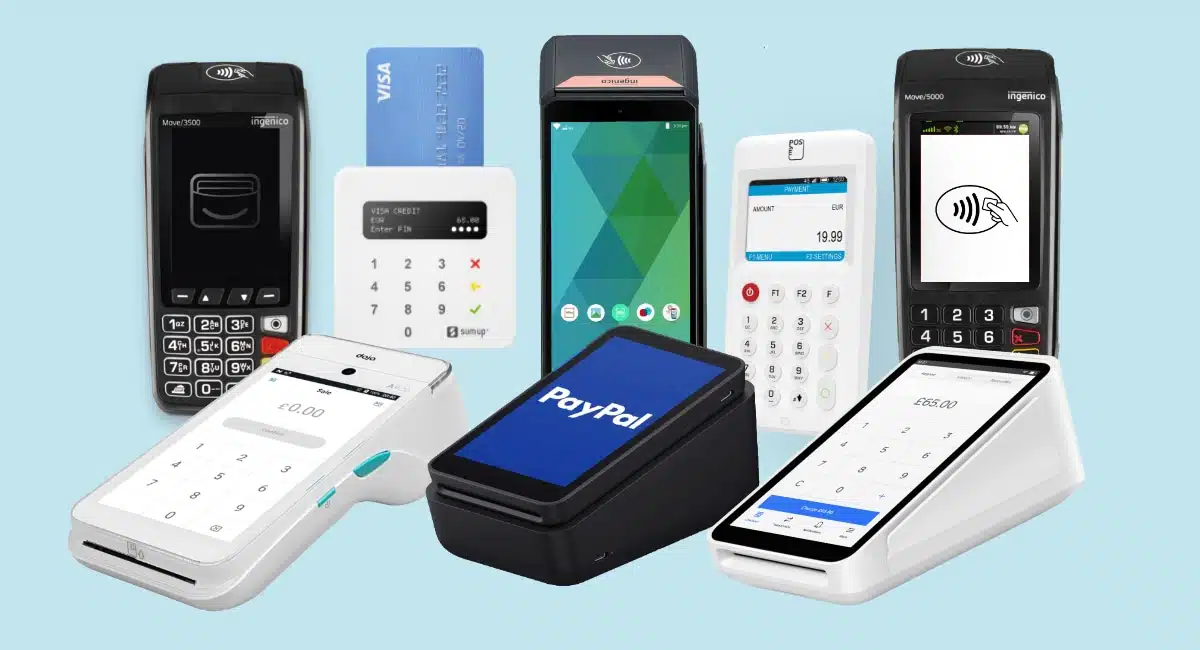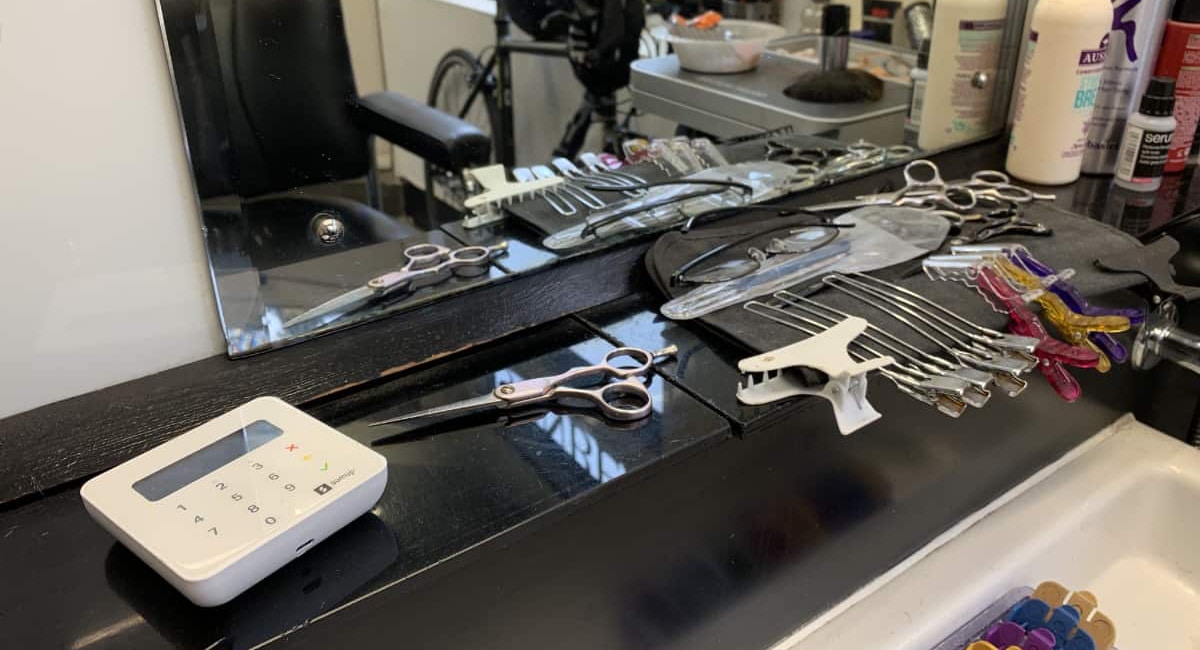SumUp and myPOS are increasingly similar payment products that cater to small businesses.
Both sell card machines that come with complimentary payment tools and a business account. They don’t lock you into a long contract, instead opting for pay-as-you-go pricing and no monthly fees.
The platforms have lots of differences too, though. Let’s compare the two payment services and find out which is better for you.
Versatile card machine collection
The main reason merchants go for SumUp or myPOS is to get an affordable card machine. They have a card reader for any occasion, though SumUp tends to be cheaper while myPOS’s selection is higher-end.
SumUp’s card machines are the most unique
SumUp sells three models:
- Air – palm-sized, app-dependent
- Solo – palm-sized, works independently, bought with or without a receipt printer
- Terminal – works independently, has a receipt printer and scanner built in
Standalone SumUp Solo (£71.10 + VAT) and Terminal (£121.50 + VAT) include a SIM card with unlimited free data, so they can be used anywhere with a mobile network or WiFi. SumUp Air (£12.50 + VAT) , on the other hand, connects with an app on your smartphone or tablet, using the mobile device’s internet connection to process cards.
Photo: Emmanuel Charpentier (EC), Mobile Transaction
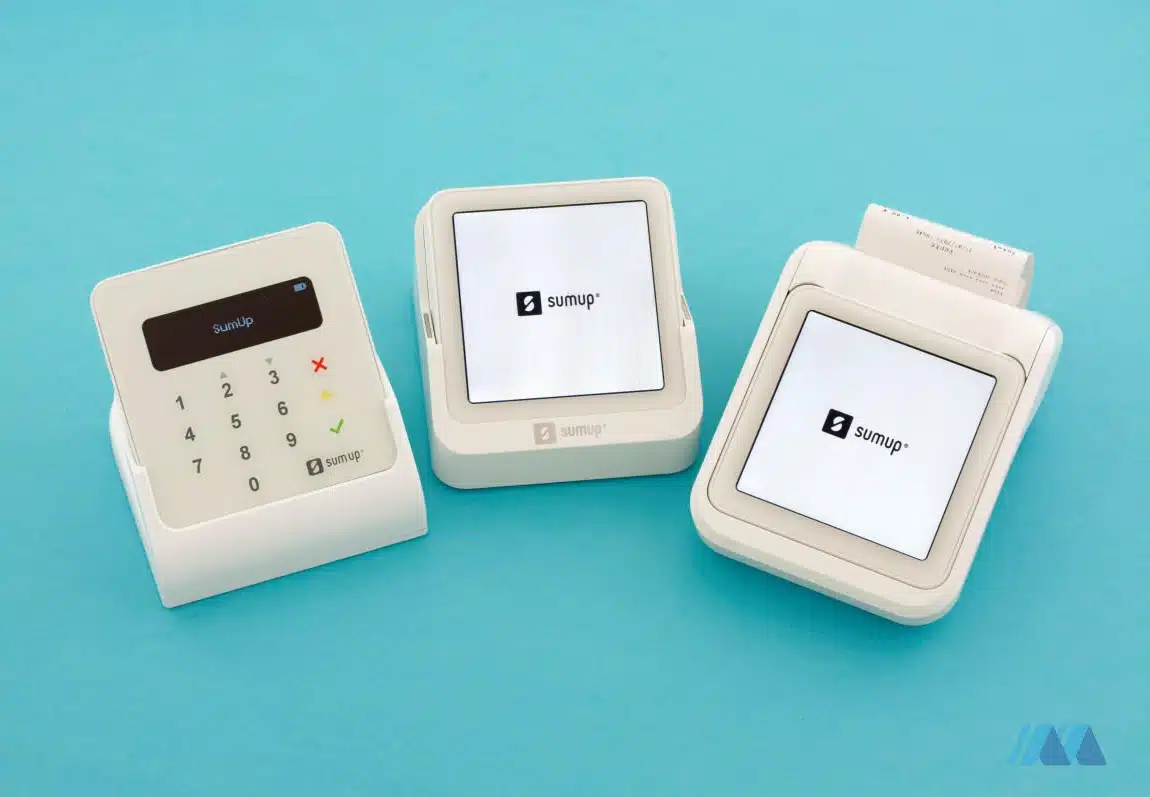
SumUp Air, SumUp Solo (in a basic stand) and the Solo Printer bundle.
Solo just does the basics: accepts contactless payments and chip and PIN cards, as well as tips. The payment flow usually worked okay when we tested it, and the battery life has extended greatly since our first try when it was launched, but not that much. You should get the package with a printer (£98.10 + VAT) which doubles as a power bank, if battery life is a concern.
While Air also just takes payments, its connected app lets you use more extensive point of sale (POS) features for a till point, like a product library and VAT rates. The paid SumUp Point of Sale app gives you many more, customisable features for hospitality and retail.
Newly-launched SumUp Terminal is better if you’re looking to use the same device for everything. It accepts most payment methods (including cash), has a product library, customer directory, invoicing, business account access and more. It also prints itemised, but small, receipts.
Photo: Emily Sorensen (ES), Mobile Transaction
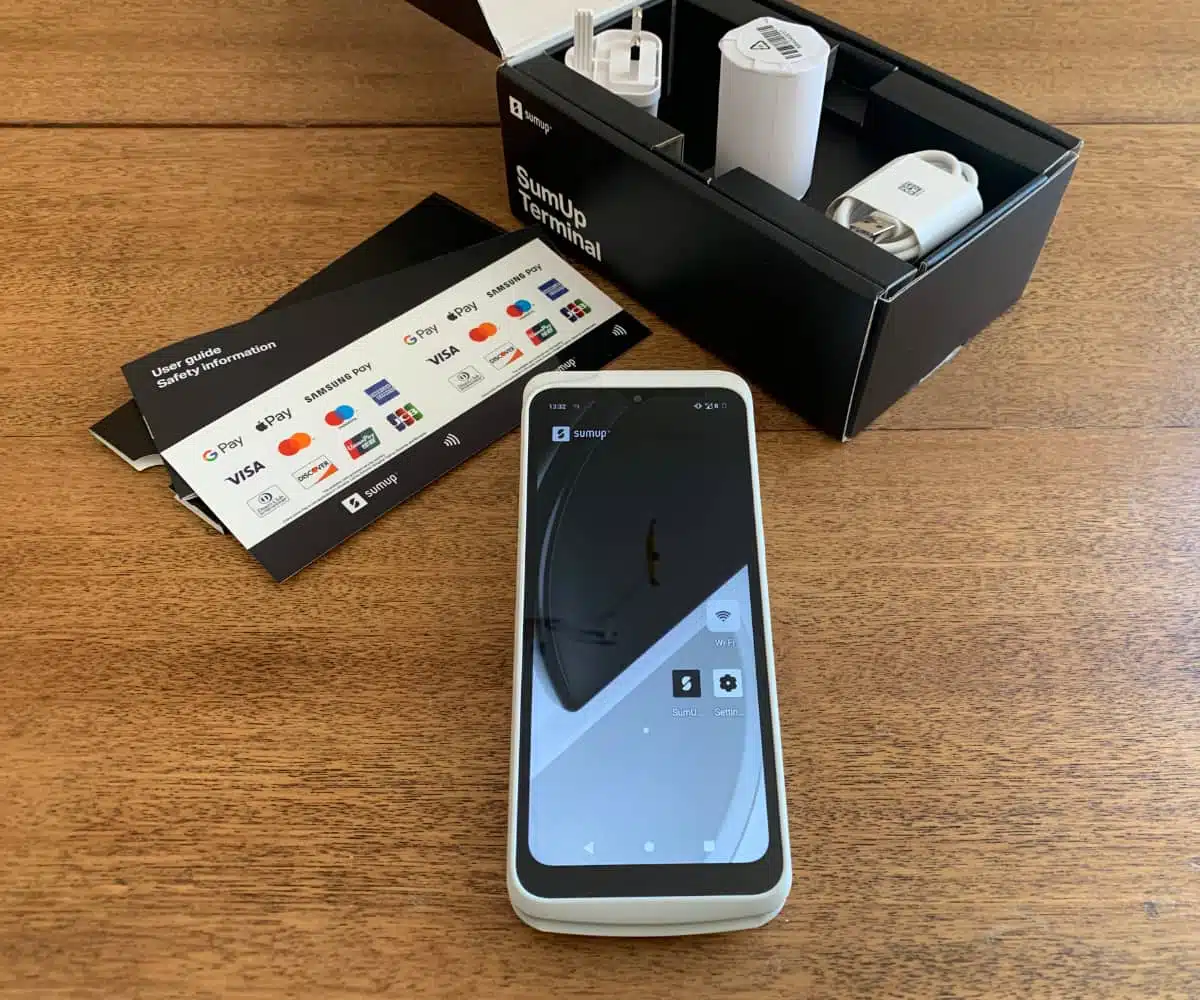
We were happy with our SumUp Terminal package – it looks sleek and is better quality than Solo.
myPOS’s card machines can do a bit more
myPOS has two independent, mobile card machines that come with a SIM card:
- myPOS Go 2 – small, independent, push-button card reader with or without a receipt printer
- myPOS Ultra – high-end, independent touchscreen terminal with built-in printer
myPOS Go 2 is the cheapest (£29 + VAT) because it’s a simple card reader that looks a bit like a calculator. It works with mobile networks and WiFi – a big improvement on the preceding model that didn’t have WiFi connectivity. For a much higher price (£169 + VAT), you can buy it with a receipt printer.
Photo: EC, Mobile Transaction
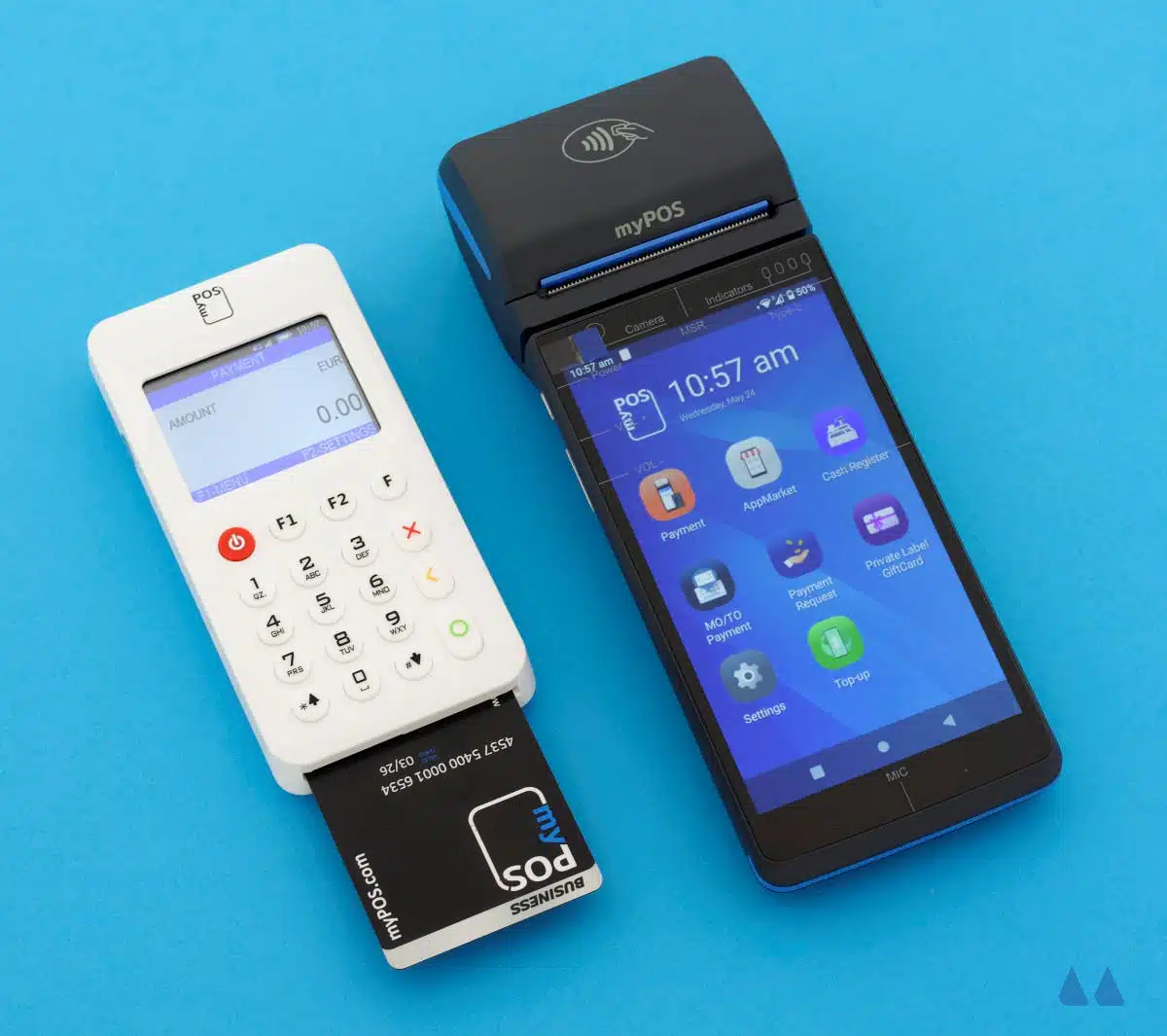
The compact myPOS Go 2 next to the old myPOS Pro terminal that’s been replaced by Ultra.
The more robust myPOS Ultra (£229 + VAT) has a built-in receipt printer, large touchscreen and multiple-days’ battery life. With its advanced Android software, you can download additional apps for, say, online payment methods. This is a card terminal for merchants who want to give a good impression.

myPOS Ultra is faster, with a longer-lasting battery, than its predecessor Pro.
All of myPOS’s terminals have some useful features, like sending payment requests for remote payments, gift card acceptance and preauthorisations. A POS app is available on Ultra, along with other industry-specific apps for retail, hospitality and services, such as taxi dispatch software.
What if the card machine is down? Not an issue with Tap to Pay
myPOS Glass for Android and iPhone lets you accept tap-to-phone transactions via your mobile device’s NFC chip. SumUp also offers contactless payments on iPhone and Android through its main app.
We think these are genuinely handy solutions, but they are mainly for merchants who have purchased a card terminal.
SumUp fees are predictable and lower
How do the costs stack up?
SumUp definitely wins the battle of simple, hands down. Its card readers fall in the range of £12.50–£121.50 + VAT, and then you only pay a transaction fee of 1.69% for all tap and chip transactions, even if the card is premium like American Express or issued abroad. There’s no contract lock-in or monthly fees, but an optional Payments Plus subscription (£19/month) lowers the domestic card rate to 0.99%.
myPOS’s card machines cost between £29–£229 + VAT, plus a mandatory shipping charge of £6. As with SumUp, there’s no monthly fee, and you can cancel the account any time. The transaction fee for domestic Visa and Mastercard transactions is only 1.1% + 7p, whereas Amex is 2.45% + 7p and all other cards are 2.85% + 7p.
myPOS and SumUp fees compared:
| Cost types |  |
 |
|---|---|---|
| Shipping | Free | £5 + VAT (£6) |
| Fixed monthly fees | None | None |
| Visa, Mastercard (from UK/EEA) transactions | Pay-as-you-go: 1.69% Payments Plus (£19/mo): 0.99% |
1.1% + 7p |
| Premium, international card transactions | Pay-as-you-go: 1.69% Payments Plus (£19/mo): 1.99% |
Amex: 2.45% + 7p Others: 2.85% + 7p |
| Payouts | Free in bank account or SumUp account | Free in myPOS account, £1.50 bank account transfer |
| Refunds | Free | Free |
| Chargebacks | £10 each | £15 each |
| Inactivity fee | None | £15 + £30/mo applies after 10 months’ inactivity |
SumUp doesn’t charge anything for settling transactions directly in a bank account or SumUp Business Account (your choice where payouts go).
myPOS, on the other hand, only settles card payments in your online myPOS account, not a bank account. To transfer myPOS funds to your UK bank account, a £1.50 transfer fee applies each time. You can make other transfers, such as SWIFT, for other fees.
Withdrawing cash from the myPOS online account with its card costs at least £2 each time. In contrast, SumUp Card gives you 3 free cash withdrawals per month, followed by a 2% fee until the next month.
There are other myPOS charges related to text messages, account statements and so on, so it’s not overall that transparent compared with SumUp. If you haven’t taken any transactions for 10 months, a monthly inactivity fee of £15 + no acquiring fee of £30 apply per month until you either close the account or transact again.
With SumUp, you don’t have to close the account when you’re done using it, as it won’t charge you anything down the line.
Both have business accounts, but different payout speeds
A big difference between the systems is how transactions clear.
SumUp settles money directly in your bank account within 2-3 working days. These payouts can be scheduled daily, weekly or monthly.
You also have the choice to settle transactions the next day (weekends included) in the complimentary, online SumUp Business Account that has an account number and sort code.
myPOS clears transactions immediately in an online business account, not a bank account. From here, you can manually transfer it to a bank account.
The myPOS account comes with its own IBAN so you can use it as a central, international business account for cross-border payments. It also allows you to create sub-accounts with different currencies to avoid currency conversion fees.
On both platforms, transactions can be accessed in a mobile app or online dashboard, where you can print reports as well. But SumUp has the added advantage of letting merchants manage their business account on one of their card machines (Terminal).
Both offer a business card with fast access to funds
Rather than paying to transfer from the myPOS E-money Account to bank account, you can use the complimentary myPOS Business Card for direct access to funds in the online account where transactions settle immediately. It is a Mastercard prepaid card that can be used anywhere, and you can withdraw cash.
Photo: EC, Mobile Transaction
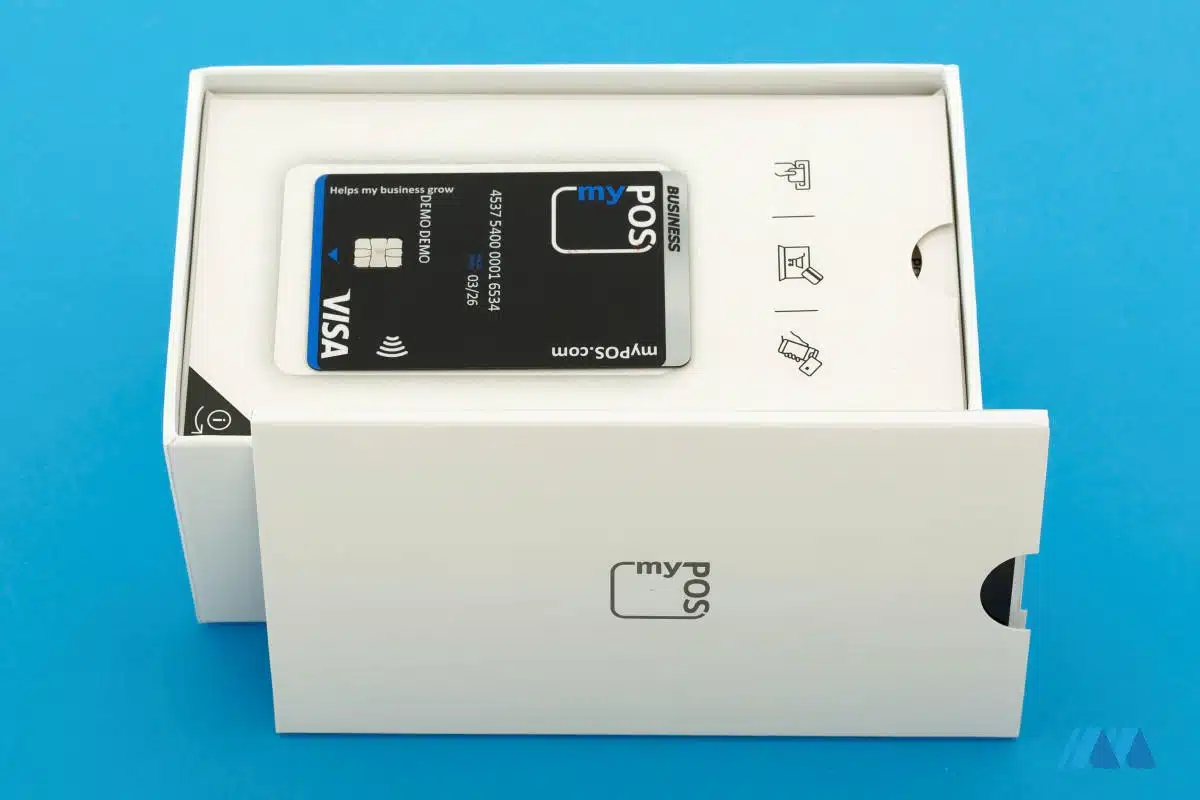
All of myPOS’s card machines come with a free business card for quick access to funds.
SumUp also gives you a prepaid Mastercard connected with the online business account. Card transactions settle in this account the next day, including weekends and Bank Holidays – SumUp’s fastest way to access funds.
myPOS accepts European mobile wallets
SumUp and myPOS accept similar card brands. They both accept Visa, V Pay, Mastercard, Maestro, American Express, JCB and UnionPay as well as Apple Pay and Google Pay. On top of those, only SumUp accepts Diners Club and Discover.
These are more than enough for most merchants, but touristy shops may want myPOS’s additional options too: Samsung Pay, Bancontact and iDEAL.
The latter two are Belgium- and Holland-based mobile wallets respectively. They are primarily used in mainland Europe, but British merchants can still accept them.
No lack of online payment tools
Both platforms include many tools for online and remote businesses, including an:
- Online store builder
- Payment links
- Invoicing software
- Virtual terminal (for over-the-phone payments)
In addition, SumUp lets you generate QR codes for touch-free payments. The website builder is actually used in SumUp App and on SumUp Terminal, allowing you to create a basic site anywhere quite quickly to advertise on social media. All of these tools are very intuitive, simple and lacking in complexity.
myPOS’s tools are generally a bit more complicated. For example, you can integrate an online checkout in your chosen ecommerce store, instead of using myPOS’s own website builder. Most of the online features require you to log into a browser dashboard, in which case you need a computer.
Both can be used abroad, but need permission with SumUp
By default, a British SumUp account works within the UK border only. That said, you can notify SumUp’s customer service of any travels to another European country where they are offering services as well. You may then be granted permission to use the card machine in that country during the time you’re away.
As an openly European company, myPOS doesn’t require such an arrangement. The SIM card in the card reader automatically works in all EEA countries.
Sign-up is easier with SumUp
Sign-up is a simple, 5-minute process through SumUp’s website, and then you just order the card reader while your bank account and business are verified within a few days. It cannot be any easier, although receiving the card reader can take around a week.
After the initial sign-up form on the website, myPOS additionally requires an identification check over video and submission of paperwork. This whole process usually takes days, which is not ideal when you just want to get moving.
Photo: ES, Mobile Transaction
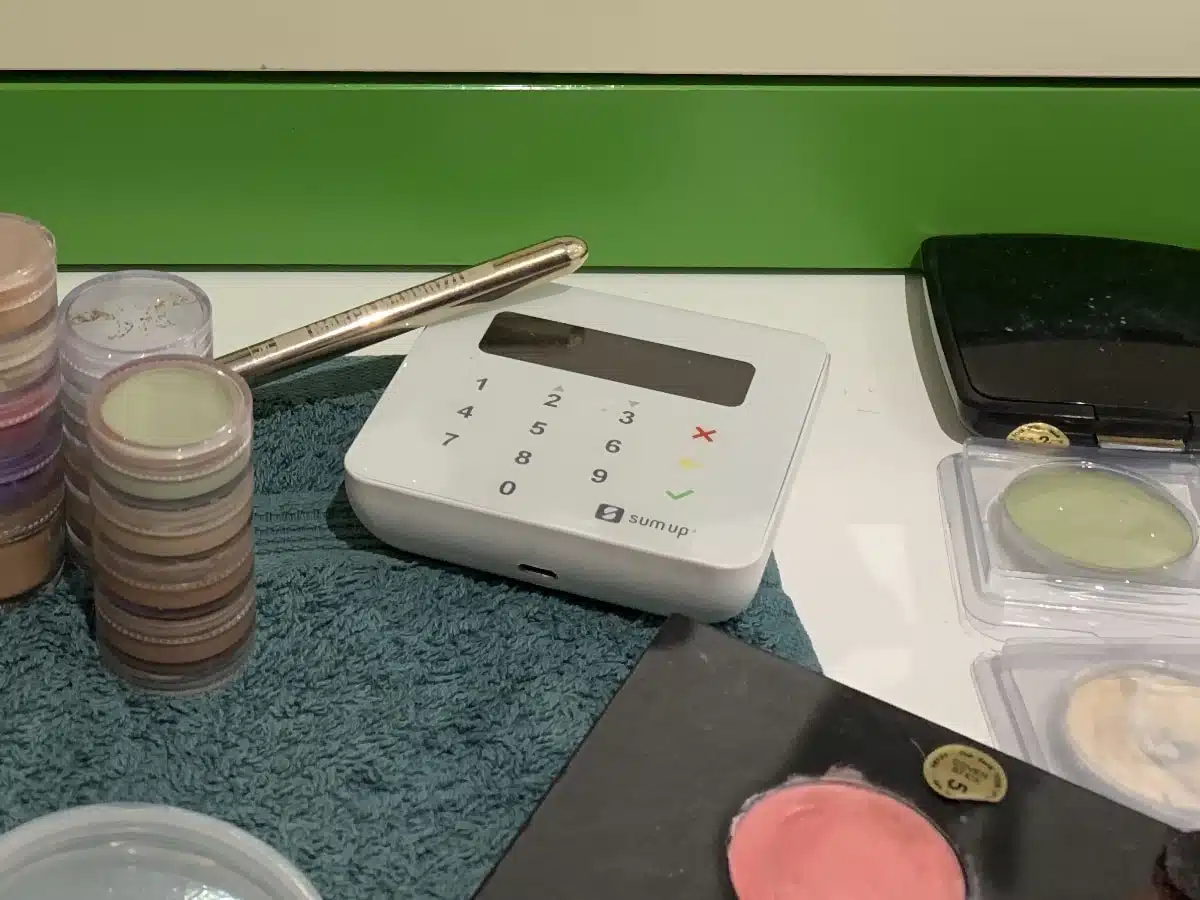
SumUp Air looks inconspicuous in most environments – here seen at a beauty salon.
Which is best for whom?
Both providers are catering to startups, sole traders and small businesses that just want to get paid as easily as possible. They are affordable pay-as-you-go terminals with no long-term contracts, unlike many other card machines that come with rental lock-in.
The mobility of the devices makes them ideal for restaurants and cafés for table service, but any small shop or mobile business can use them as a lightweight solution to payments anywhere. But SumUp is usually more attractive to these businesses with its fast sign-up and British presence.
Taxi drivers may prefer myPOS, since their terminals can integrate with dispatch software for cabs.
If it’s not important to manage card revenue via a bank account, myPOS has the advantage of immediate access to funds with a business card. SumUp’s next-day access to funds via the free business account is not bad either.
SumUp is better for bank account transfers, app access to features and lack of hidden fees. myPOS’s terminals are more advanced, with interesting features like preauthorisation and flexible use abroad.
![]() Emily Sorensen, Senior Editor at Mobile Transaction
Emily Sorensen, Senior Editor at Mobile Transaction
Our verdict: SumUp more generalist, myPOS has niche tools
Both card payment solutions work out as good, commitment-free alternatives to rented terminals, but SumUp takes the prize of being cheapest, easiest and most transparent for everyone. SumUp’s free bank account settlement and fixed percentage for all cards are draws for many merchants.
myPOS, on the other hand, can be convenient for international businesses with its multi-currency account and instant access to funds. Unlike SumUp, it also has tools for taxi drivers and hotels (preauthorisations), but comes with more fees, some of which are less than clear.
Both platforms have many extra tools for online payments, invoicing, the point of sale and more. While the many simple features of SumUp are nearly all accessible in an app, myPOS’s ecommerce tools are best accessed from a web browser.
The mobile terminals of myPOS are generally better for high-volume businesses, given their adaptable features. In contrast, SumUp’s cheap payment terminals are built for ease of use and aesthetic appeal.

